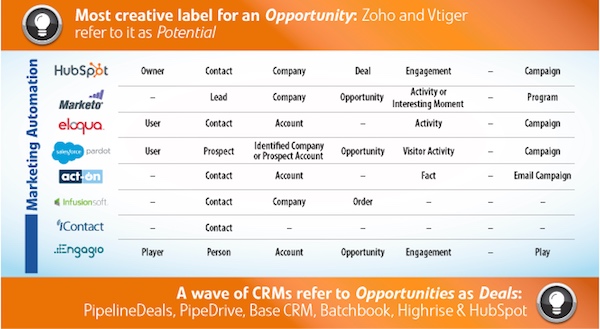Eskimoes have a large number of words for “snow” — or so goes a cliché meme that’s been around for decades. Exactly how different those words are, compared to the languages of any other culture in the world, is a matter of debate.
But it’s a remark that almost always elicits a chuckle, since one pictures Eskimoes having a lot of snow in their lives (global warming notwithstanding). So it seems natural that they would acquire a large vocabulary to describe the many different contexts and characteristics of snow.
So, how many different words do you think marketers have for key data records in CRM and marketing automation systems?
Not surprisingly, quite a few.
Also, not surprisingly, they vary from one martech vendor to another. What HubSpot calls a Contact, Marketo calls a Lead, Salesforce Pardot calls a Prospect, and now ABM-darling Engagio calls a Person. So you can really confuse the hell out of someone by asking if they’ve made contact with a lead and determined if that person is a prospect.
But I didn’t fully appreciate the scope of this martech-rose-by-any-other-name phenomenon until I ran into Zak Pines, VP marketing at Bedrock Data and author of the Moneyball Marketer blog, at the #FlipMyFunnel event in Boston a couple of weeks ago.
Zak showed me a preliminary version of the epic infographic at the bottom of this post that attempts to align the different names for key records across 67 marketing technology vendors.
It’s like a Rosetta Stone of martech terms!
I love stuff like this, because it illuminates the challenges we’re wrestling with in marketing technology management — and nomenclature is no small one — but also helps improve the situation by revealing some measure of order below the chaos.
I asked Zak to share a few thoughts on this:
1. For context, what does Bedrock Data do and what’s your role at the company?
Bedrock Data automates cloud integrations. Our customers use our product to connect and synchronize multiple cloud systems in real-time. It’s a key technology for getting customers to a single view of the customer and helping them become more agile with their processes and reporting.
My role is to head up marketing, and creating content of value to our prospects and customers is an important part of our marketing.
2. It’s pretty self-explanatory, but can you describe this infographic and how it came about?
I have the good fortune of sitting right next to the sales team on the phone with customers every single day. The conversations always center around which systems a customer is looking to connect — sometimes three, four even five systems.
It was clear from these customers that every system has their own unique nuances — what types of data they center around, how that software vendor chose to organize its system and what they call things.
3. What are some of the most interesting takeaways from this graphic for you?
First off, it reinforced some of the lessons of your marketing technology supergraphic — that there are many, many cloud systems out there, and that data is often dispersed across those systems.
It’s also a good visual to demonstrate why it’s so hard for companies to get to a single view of the customer. With so many systems, many of which are performing departmental or specific sub-departmental functions, and each with their own unique terminology, you get a sense of the challenge.
The other takeaway which I mentioned in the article published alongside it, is that although vendors may want it to be the case, these systems don’t map to the customer journey in a linear fashion. If you plot the customer journey to these systems, it will bounce all over. So when thinking about aligning this data, it’s not about moving data from point A to point B, it’s about bringing all this data together for a single, consistent view of the customer.
4. Even though the labels vary from one system to another, how similar are the underlying record structures? How big of a problem is this at the next level down, the individual fields associated with things like contacts, companies, and opportunities?
At a basic level, there’s similar data being managed that people care about. People have names and email addresses and phone numbers. Opportunities have a $ amount, and a status and a close date.
But you’ll find that each software company has solved it in their own unique way. It was probably driven at the inception of that product by a product manager or an engineer, and the nomenclature for that system has stuck.
5. Do you think this genie can ever be put back in the bottle to define one common data language for modern marketing?
I think that’s very ambitious for the industry, Scott.
I think step one, and probably the most important step, is for individual companies to have standard terminology and definitions that they are using across their business.
The different system terminology adds to the confusion, but I’ve seen many companies where not only are the systems using different nomenclature, but the teams are too in their day-to-day interactions. You’ll hear questions like, “What’s a lead? What’s a contact? What’s a campaign? What’s a program?”
Tying back to the infographic, the line across the top is the Bedrock Data term that we use as a standard. So when we are working with customer and connecting multiple systems, data is getting normalized across all of the connected systems using a common Bedrock term.
Thanks to Zak and the team at Bedrock Data for pulling this together!
And if you’re looking to make more sense of marketing technology management, be sure to check out our upcoming MarTech Europe conference in London, November 1-2. You can use the code “MarTechInsider” (case sensitive, without the quotes) to receive an extra 10% discount.






Imagine building a migration wizard to export/import data between different systems.